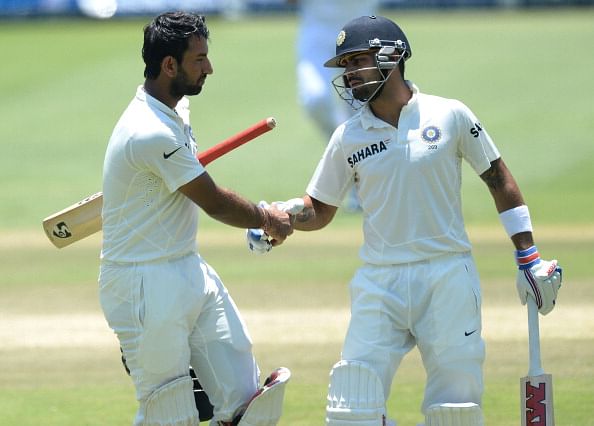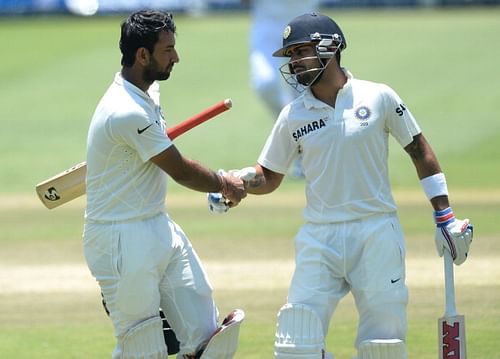
England v India 2014: Test Series Review

Having pronounced that India had the advantage running up to the start of this recently concluded Investec Test series, and having quietly gloated after their historic Lord’s win, their nosedive has come as a strong jolt. As if experiencing a protracted choke, India fell almost totally impotent in all areas of the game since the first morning at Southampton. From that point onwards, they hardly won a session, and certainly not a single day’s cricket.
From scaling the highest mountain at Lord’s, India plunged headlong into the deepest abyss at The Oval. At Southampton, the Test went into the fifth day, perhaps only due to the fact that England took first strike and amassed a massive 569/7 declared. The final two Tests were over in three, even with over 60 overs being lost to rain in Manchester.
These have got to be the worst Three Tests performances India has strung together in recent times, with the nadir reached at The Oval. After threatening to fold for under a hundred on quite a few occasions, they finally managed it on their last attempt, shut down for 94 at their last turn at the crease. For a team that arrived in England with a much-heralded batting line-up, their lack of runs and resolve has been astounding.
Technique needs tightening for the younger brigade
Surely, Virat Kohli and Cheteshwar Pujara have the quality to succeed in all conditions. Both made classy hundreds against the proficiency and power of Dale Steyn, Morne Morkel and Vernon Philander in South Africa, with Kohli repeating it in New Zealand against their highly capable seam-bowling attack. Not long from now, in October to be exact, India will be entertaining the West Indies, and I’m willing to wager that the duo will be among the runs. So why then -- when so much was expected of them, and when they showed every indication of being able to produce anywhere -- did they so utterly fail in England?
One thing we have seen over the years: if there is any vulnerability in your batting, then English conditions will certainly find you out. India’s young brigade was not the first, nor will they be the last, to be overmatched by the seam and swing available in England. At least now they know they have to tighten their technique if they hope to follow in the footsteps of the legends they succeeded.
England bowling unit
India’s batsmen also had the misfortune of having to combat the canniest swing bowler in the game in conditions tailor-made for his type of art. Jimmy Anderson was cantankerous, talkative, aggressive, miserable; more importantly, though, he was also quick, skillful, consistent. To novices unused to conditions, he was nigh unplayable on occasion.
Stuart Broad was not far behind, capturing 19 wickets to Anderson’s series-high 25. And, if the capabilities of the back-up seamers were sometimes questioned, they showed they were often up to the task of polishing off the tail after the top and middle orders were set aside by the two top guns.
One thing India’s batsmen should not be forgiven for is the beneficence they granted to Moeen Ali . Not that his bowling is fodder -- he can keep a line and is improving all the time, but, in two games against Sri Lanka, he took three wickets at 60.33; India, on the other hand, allowed 19 at a meager 23 average.
At the start, they seemed to go after him, seemingly dismissive of any threat the upstart could pose. Later, as he proceeded to do damage, they appeared strokeless against him, typifying the quandary of confusion into which India’s batting had fallen. As the series drew to a close, his services as a bowler was hardly required, as England’s seamers were wrapping up India’s batting without breaking sweat.
Too many worrying signs
Victory at Lord’s was heartwarming to the game’s largest fan-base and rightly attracted acclaim and triggered celebrations. But there were worrying signs aplenty if we dared to delve below the surface.
Save for the very patient and focused Murali Vijay, the top order never fired, and the runs came mainly from the opener, Ajinkya Rahane and the lower order, including Bhuvneshwar Kumar who reeled off three half-centuries in his first four innings of the series, his other effort being 36. This was an unsustainable state of affairs. The lower order will not bail you out every time, or even all that often; the top and middle orders have to regularly produce for the team to prosper.
Rahane scored a splendid century at Lord’s, one of the better knocks of the series, but India’s win was mainly due to Kumar’s 6/82 in the first innings, and especially to Ishant Sharma’s 7/74 in the second. England really fell off the cliff, however, when they fell into a hooking frenzy in response to Sharma’s Dhoni-inspired, short-pitched attack.
This was a risky tactic that, fortunately for India, paid off handsomely. But it was not a tactic that they could hope to employ successfully going forward. England were never going to fall into that trap again, and so India’s bowlers would have to rely on more conventional means for wickets. Unfortunately, wickets got harder to come by as the series wore on, and as the bowlers grew weary, and as Dhoni struggled with his keeping and his captaincy, and as the slip catchers became more butter-fingered.
Australia, and not West Indies, the real challenge
Dhoni and his brigade have much work to do. Questions are now being asked about his leadership position; however, the man earmarked to succeed him had an awful tour himself. Kohli will regain his batting form soon enough, but his ascension to the captaincy is not yet at hand.
It is very likely that India will return to its usual winning ways at home when the West Indies come calling in October. But, in December, they visit Australia, and lying in wait will be one of the most destructive forces in cricket history. Mitchell Johnson, ably assisted by his fast bowling comrades and a line of mostly forceful batsmen, will only be too happy to do to India what they did to the last side that set foot Down Under.
Having defeated Australia a few months earlier, England arrived in Australia on top of the world. They returned home in shambles. Bats were broken, careers were curtailed, illnesses exacerbated, retirements hastened, and relationships unraveled. If India do not get their house in order by then the result could be even more humiliating than the recent beating administered by England.